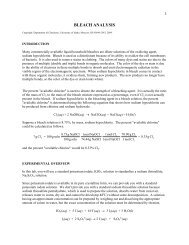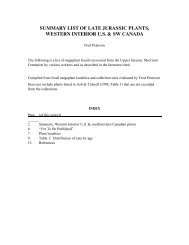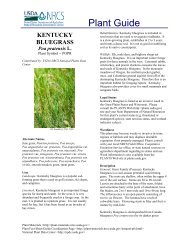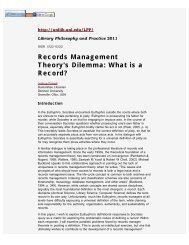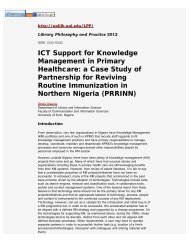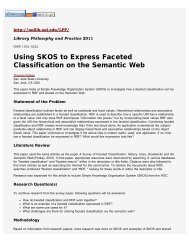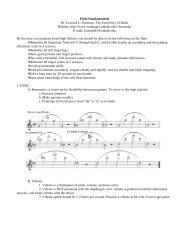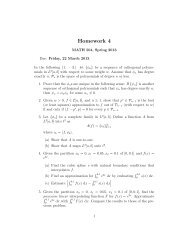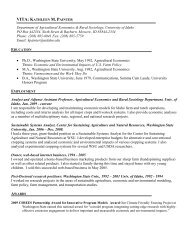Value-added Utilization of Crude Glycerol from Biodiesel Production ...
Value-added Utilization of Crude Glycerol from Biodiesel Production ...
Value-added Utilization of Crude Glycerol from Biodiesel Production ...
You also want an ePaper? Increase the reach of your titles
YUMPU automatically turns print PDFs into web optimized ePapers that Google loves.
liquid phase). In an additional fermentation, an expensive nitrogen source was substituted by meat and<br />
bone meal beside the glycerol liquid phase as a carbon source resulting in a final PHA concentration <strong>of</strong><br />
5.9 g/L. Ashby (2005) reported the synthesisation for polyhydroxyalkanoates by mixed culture<br />
fermentation <strong>of</strong> glycerol. P. oleovorans and P. corrugata grew and synthesized poly (3-hydroxybutyrate)<br />
(P3HB) and medium-chain-length PHA <strong>from</strong> glycerol at concentrations up to 5%vol. P. oleovorans (1.5<br />
mL <strong>from</strong> overnight LB broth culture) was inoculated 24 h prior to P. corrugata (1.5 mL) and the flasks<br />
allowed to incubate as described above for a total <strong>of</strong> either 48 or 72 h. Cellular productivity maximized at<br />
40% for P. oleovorans in 5%vol glycerol and 20% for P. corrugata in 2%vol glycerol after 72 h. Increasing<br />
the glycerol media concentration <strong>from</strong> 1% to 5%vol caused a 61% and 72% reduction in the molar mass<br />
<strong>of</strong> the P3HB and mcl-PHA polymers, respectively. The growth patterns <strong>of</strong> P. oleovorans and P. corrugata<br />
on glycerol permitted their use as mixed cultures to produce natural blends <strong>of</strong> P3HB and mcl-PHA. By<br />
incorporating a staggered inoculation pattern and varying the duration <strong>of</strong> the fermentations, P3HB/mcl-<br />
PHA ratios were achieved that varied <strong>from</strong> 34:66 to 96:4.<br />
<strong>Glycerol</strong> Processing by Different Processes and<br />
Other Uses<br />
Demirbas (1998) delignified wood and agricultural materials in glycerol at atmospheric pressure, for the<br />
production <strong>of</strong> pulps. Air-dried wood discs were reduced in size before chemical treatments. Each chipped<br />
ground wood sample was mixed to facilitate homogeneity and stored in polyethylene containers at 253 K<br />
before delignification assay. The wood powder or the chips were loaded into a 250 mL autoclave. In this<br />
experiment 9 g <strong>of</strong> wood were treated in 45-75%wt glycerol, using a charge ratio <strong>of</strong> wood/solvent <strong>of</strong> 9/70-<br />
9/100(g/g) and 0.5-1.0%wt NaOH or Na2CO3 as catalyst, or without catalyst. The maximum delignification<br />
temperature was 498 K, with or without mechanical stirring, and 3-9 h <strong>of</strong> cooking time. At the end <strong>of</strong> the<br />
delignification, fractions were separated <strong>from</strong> unreacted wood by filtration. The optimization <strong>of</strong> the<br />
aqueous glycerol delignification conditions <strong>of</strong> Ailanthus wood chips at 440-500 K temperatures, long<br />
cooking times, and using a catalyst was carried out. The best results were obtained with 72% glycerol<br />
using a ratio <strong>of</strong> wood/solvent <strong>of</strong> 9/100 (g/g), 1%wt NaOH as catalyst, 0.3 mm chip thickness, 498 K<br />
temperature, and a cooking time <strong>of</strong> 9 h. Under these conditions about 94% <strong>of</strong> the initial wood lignin was<br />
removed. Pulps obtained under these conditions gave pulp yield, Kappa number, and Klason lignin in the<br />
range <strong>of</strong> 53%, 16 and 8%, respectively. Aqueous glycerol showed a better effect than non-aqueous<br />
glycerol on the pulp fiber-length and pulp yield. Xu et al. (1996) reported that gasification <strong>of</strong> feedstocks<br />
like glycerol in super critical water could be catalyzed by varieties <strong>of</strong> charcoal and activated carbon to<br />
produce hydrogen-rich synthesis gas. The reactor used was made <strong>of</strong> Inconel 625 tubing with 9.53 mm<br />
(outer diameter) and 4.75 mm (internal diameter). It was maintained at isothermal conditions by a furnace<br />
and a downstream heater. <strong>Glycerol</strong> completely decomposed in supercritical water (without a catalyst) to a<br />
hydrogen rich synthesis gas after 44 s at 600°C and 34.5 MPa. Pressures above about 25 MPa were<br />
adequate to realize high gasification efficiencies. Yang and Tsai (1997) reported that Poly (ethylene<br />
terephthalate) fabrics could be treated with sodium hydroxide using glycerol as the solvent. Du et al.<br />
(2005) reported the process for synthesisation <strong>of</strong> carbon onions via thermal reduction <strong>of</strong> glycerol. In their<br />
experiment, 0.45 g <strong>of</strong> magnesium powder (99%) and 5 mL <strong>of</strong> glycerin were mixed in a stainless steel<br />
autoclave <strong>of</strong> 25 mL. The autoclave was sealed and maintained at 650 °C for 12 h, then cooled to room<br />
temperature naturally. The following reaction occurred.<br />
A portion <strong>of</strong> the black product was directly characterized by X-ray diffraction. The yield <strong>of</strong> carbon onions<br />
was about 60%. The obtained carbon onions had diameters ranging <strong>from</strong> 60 to 90 nm. Brown et al.<br />
(1999) showed that glycerol could be used as a dielectric medium for compact pulse power systems. The<br />
high intrinsic time constant (10.7 ms at 0°C) and high dielectric constant (42.5 at 25°C) makes it suitable<br />
for repetitive systems operating with charge times in excess <strong>of</strong> 1ms. Kochegarov and Belitskaya (1971)<br />
reported that glycerol could be used for Indium-Antimony alloys deposition <strong>from</strong> indium and antimony<br />
chloride-tartrate solutions in glycerol. The electrolysis conditions were cathodic current density 0.25 to<br />
0.5-amp d/m 2 and the temperature being 85°C. The indium content in the alloy increased with increase <strong>of</strong><br />
current density and with decrease <strong>of</strong> antimony concentration in solution. Stirring raised the antimony<br />
10




